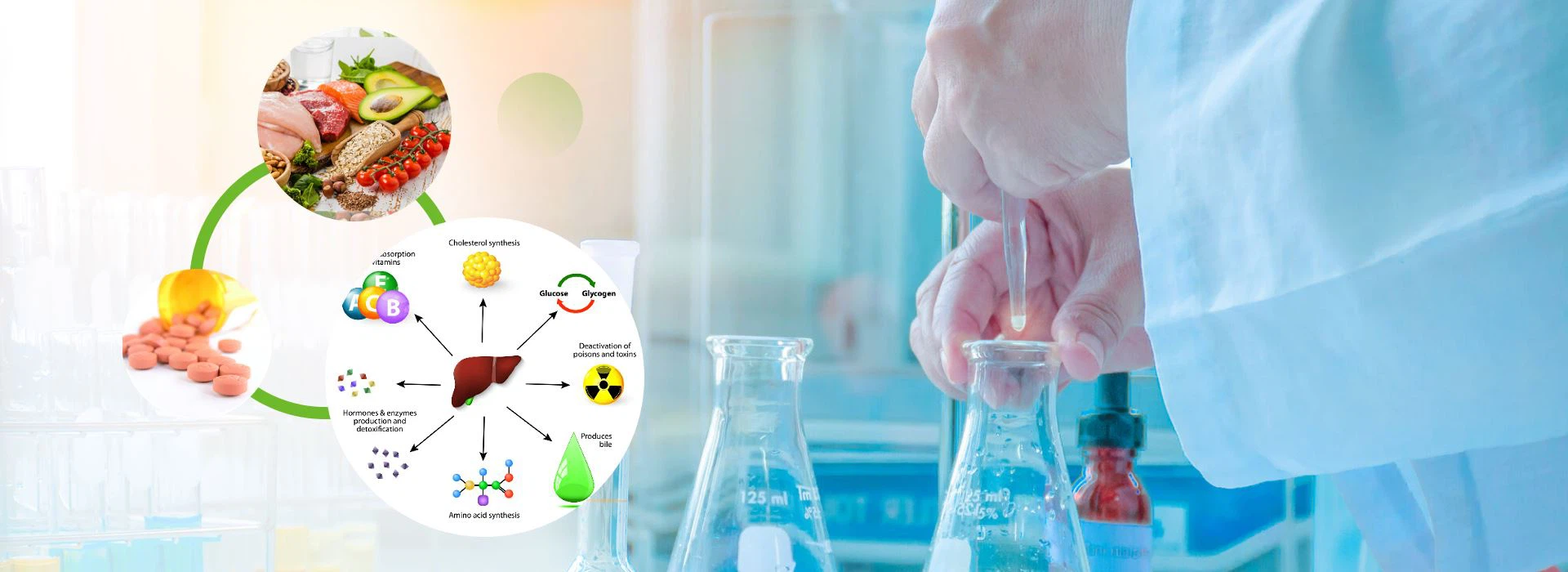
Aug 10, 2023 / Author: China Glutathione suppliers & NMN manufacturers
Chronic exposure to UVB (280-320 nm) can lead to oxidative skin damage, inflammatory damage and skin cancer. Studies have shown that Nicotinamide Mononucleotide (NMN) and lactic acid bacteria (LAB) have certain positive effects in anti-oxidation, anti-inflammation and prevention of other age-related diseases.
The researcher Zhou Xianrong et al. used the mouse model of UVB-induced skin damage to conduct research. The mice were treated with NMN combined with Lactobacillus fermentum TKSN041 bacterial suspension in the stomach, and the serum and skin oxidation indicators, liver organ indicators and liver mRNA expression levels were used to treat the mice. and other results to evaluate the effect of NMN combined with Lactobacillus fermentum TKSN041 on UVB-induced skin damage in mice. The results were published in Frontiers in Pharmacology.
Ultraviolet radiation is considered to be the most harmful factor inducing cell aging and skin aging. This study used H&E, TB and Masson staining to test the damage degree of ultraviolet rays to mouse skin, and explored the effect of Lactobacillus fermentum TKSN041 combined with NMN on damaged skin. improvement effect.
As shown in the figure, compared with the normal mouse skin structure, the thickness of the dermis in the model group was significantly thinner, the number of collagen fiber bundles was significantly reduced, the arrangement of the subcutaneous tissue was disordered, the boundary was not obvious, and the infiltration of inflammatory cells was observed. Compared with the model group, the dermal thickness of the VC group, NMN group and L group increased, but the collagen fibers were still loose. The thickness of the dermis in the NMN+L group was significantly higher than that in the model, NMN, L, and VC groups. No collagen fiber bundle breakage was observed, and the overall structure was close to that of the normal group.
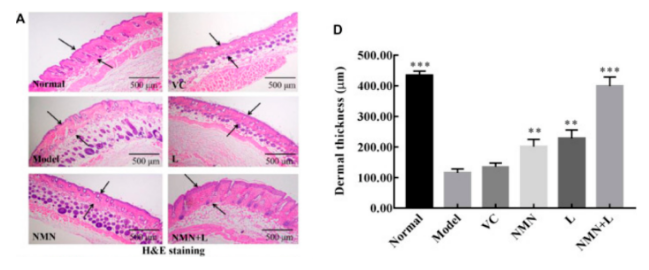
The results of Masson staining are shown in the figure. In the normal group, a large number of collagen fibers are distributed evenly and orderly. The collagen fibers in the model group are significantly less than those in the normal group, and there are fractures and shrinkages. The collagen fibers in the dermis of the VC group, NMN group and L group are significantly less than those in the normal group. , but more than model groups. The number of collagen fibers in the dermis of the skin in the NMN+L group increased more than that of the model, and the NMN, L, and VC groups were more orderly arranged with almost no shrinkage or breakage.
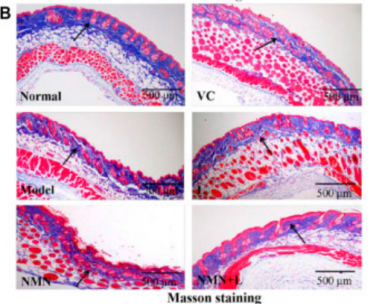
The results of TB staining were shown in the figure, UVB irradiation induced hypertrophy of skin cells and increased skin inflammation; the number of mast cells in the skin of mice in VC group, NMN group and L group was less than that of the model group, but significantly higher than that of the normal group. After the mice were treated with NMN+L, the number of mast cells in the skin of the mice was significantly reduced, and the results were similar to those of the normal group.
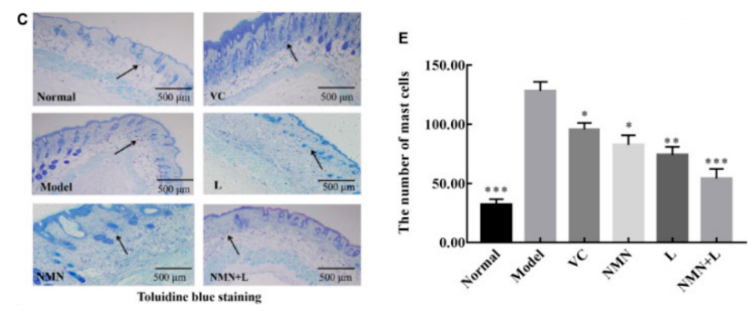
Skin and liver mRNA and protein expression levels of AMPK, NF-κBp65, IκB-α, SOD1 and CAT:
AMPK, NF-κBp65, IκB-α, SOD1, and CAT are all biomarkers of oxidative stress and inflammation. The results in panel A showed that UVB irradiation increased the mRNA expression level of NF-κBp65 in mouse skin and liver, and decreased the expression of IκB-α, AMPK, SOD and CAT. Compared with the model group, the mRNA expression levels of IκB-α, AMPK, SOD and CAT in the skin and liver of the VC, NMN, L and NMN+L groups increased to varying degrees, while the expression of NF-κBp65 decreased.
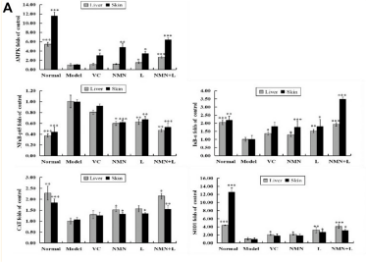
The results in Figure BC showed that UVB irradiation increased the expression level of NF-κBp65 in mouse skin and decreased the expression levels of IκB-α, AMPK, SOD and CAT. Among them, the mRNA and protein expression levels of the above indicators in the NMN+L group were close to those in the normal group.
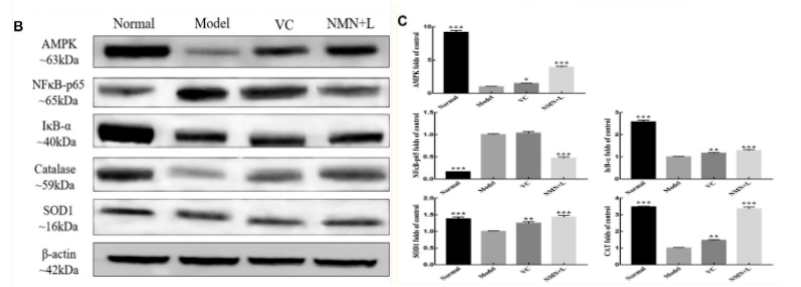
Expression levels of PGC-1α, APPL1, mTOR, FOXO α, IL-6, IL-10 and GSH mRNA in skin and liver:
The results in the figure below show that the mRNA expression levels of PGC-1α, APPL1, FOXO, IL-10, and GSH were the highest in the skin and liver of mice in the normal group, and the expression levels of mTOR, TNF-α, and IL-6 were the lowest. Compared with the normal group, the expression levels of these indicators in the skin and liver of the model group showed completely opposite trends, with significant differences between the two. After treatment with VC, NMN, and NMN+L, the expression levels of PGC-1α, APPL1, FOXO, IL-10, and GSH in skin and liver increased, while the expression levels of mTOR, TNF-α, and IL-6 decreased, The expression level of NMN+L group was close to that of normal group.
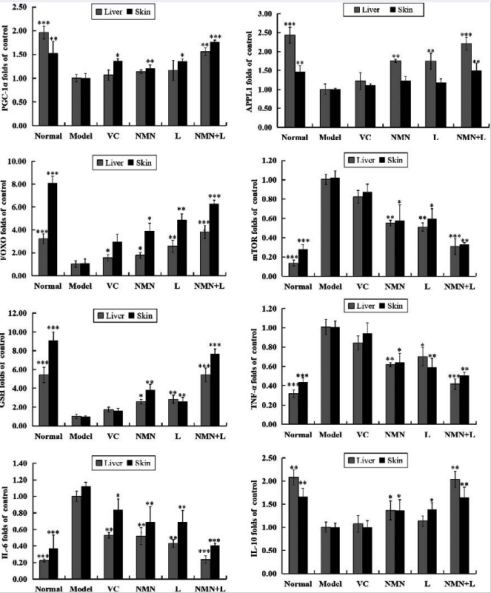
in conclusion:
NMN combined with Lactobacillus fermentum TKSN041 has good antioxidant capacity in vitro and improves UVB-induced skin damage in mice. The mechanism may be that the combination of NMN and Lactobacillus fermentum TKSN041 activates the AMPK signaling pathway, thereby inhibiting the activation of the NF-κB signaling pathway and reducing the damage caused by inflammatory mediators to mice. In addition, activated AMPK reduced oxidative damage to the skin and improved the body's overall antioxidant capacity by regulating the levels of related oxidative stress indicators in the blood, liver, and skin. This study provides a theoretical basis and sources of available strains for the development of health food combining NMN and LAB.
Supplier Introduction: China glutathione supplier and NMN manufacturer GSHworld, the company mainly develops biotechnology and industrialization. As a global pioneer in enzymatic catalytic ATP regeneration technology, our company advocates green production and is committed to providing customers with better and more environmentally friendly products and services. Glutathione Manufacturer,NMN Factory,Citicoline Sodium supplier,China NMN manufacturers
+86-755-23577295
+86 18718790084
Room 832, Building 12, Shenzhen Bay Science and Technology Ecological Park, Yuehai Street, Nanshan District, Shenzhen China